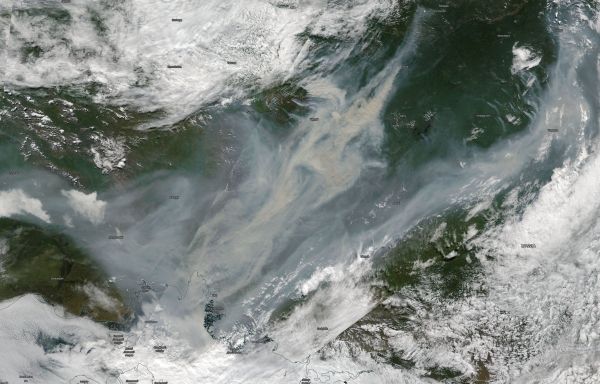Fire in the Land of Ice: Massive Wildfires Rage Over Greenland and Siberia
14
August, 2017
Like
never before, regions we typically associate with cold and ice are
being over-run by wildfires. It’s a situation brought on by
human-caused climate change. For our continued burning of fossil
fuels is causing the Arctic to warm twice as fast as the rest of the
globe. Under this oppressive influx of heat, the permafrost is
thawing. And the fragile plants, frozen lands, and soils dependent on
much cooler conditions simply cannot cope. Increasingly, and on
greater and greater scales, they are burning.
(Large
Greenland fire captured by NASA’s Earth Observatory on August 7th.)
This
past week, an outlandish wildfire ignited about 100 miles southwest
of Ilulissat near the western coast of Greenland. The fire, visible
by satellite, cast a long smoke plume even as it exploded into fierce
intensity. The odd blaze subsequently generated a rash of expert
chatter among Arctic observers on twitter even as news sources
like NPR scrambled
for contextual information.
Due
to typically very low fire incidence, Greenland lacks a national
forest fire information center. However, widespread satellite reports
and news
based observation provide
a pretty clear context for this odd event. According to news
reports from NPR,
the fire itself is a complex of multiple blazes — the largest of
which has expanded to 3,000 acres. It’s a massive forest fire. And
it’s exceptionally odd seeing such a blaze light up in
typically-frozen Greenland.
(Time
lapse of massive Greenland wildfire provided by Meteos.)
The
fire ignited as
temperatures rose to near 70 degrees (F) across the region.
A range that is well above average for this Arctic zone. And brisk,
down-sloping winds likely helped to speed the fire’s initial rapid
expansion.
Fires
do occur at times in Greenland. But they are usually rare and small.
This year’s fires, on the other hand, have been exceptional.
Preliminary satellite observation indicates that as much as 8 times
the typical number of active fires have ignited so far in Greenland
during 2017. And there is every indication that this particular fire
complex is
the largest ever recorded on
an island that is mostly blanketed by thousands of feet of ice.
(Analysis
of active wildfire pixels in Greenland satellite analysis indicates a
substantially increased rate of burning in 2017.)
The
fire itself is burning through peatlands —
which contain deep, carbon-rich soils. In many regions, thawed
permafrost ultimately becomes peat. In addition, peat itself is very
sensitive to climate change related warming. For as exceptional heat
dries the peat, it becomes a deep, dense fuel for fires. When the
fires ultimately come, they can eat far into the peat soils —
burning 3 feet or more beneath the ground.
Though
not as bad as fossil fuel burning for the climate system, peat fires
do provide a troubling amplifying feedback to human-caused climate
change if they become widespread and if large permafrost zones thaw
into peat and subsequently burn. One
researcher noted to the New York Times last year that:
“It’s carbon that has accumulated over several thousands of
years. If it were to be released, the global CO2 concentration would
be much higher.”
(Fires
burning near the melting Greenland Ice Sheet are likely in a recently
thawed permafrost zone. Permafrost contains a massive carbon store
that if released will further exacerbate human-caused warming.
Wildfires are one mechanism promoting that release. And as Arctic
lands thaw and warm, more large fires are popping up across the
Arctic. Image source: NASA
Worldview.)
Jessica
L. McCarty, an Assistant Professor of Geography at Miami
University provides
further context regarding the massive Greenland fires:
“They are likely occurring in areas of degraded permafrost, which are predicted to have high thaw rates between now and 2050 with some evidence of current melt near Sisimiut. Fires in the High Northern Latitudes release significant CO2, CH4, N20, and black carbon. A fire this close to the Greenland Ice Shelf is likely to deposit additional black carbon on the ice, further speeding up the melt.”
Siberian
Wildfires Now Extremely Intense
In
many places throughout the Arctic, rapidly warmed and dried
peatlands, forests and previously frozen permafrost zones are also
burning. In Siberia the inky smoke plumes from massive fires today
stretch for nearly 2,000 miles. Numerous fire complexes that dwarf
the odd Greenland blaze are plainly visible in the satellite picture.
(The
smoke plume in this image would blanket most of Greenland. Massive
wildfires belch giant plumes of inky smoke over Siberia and the
Arctic Ocean on August 9th. For reference, bottom edge of frame is
1,200 miles. Image source: NASA
Worldview.)
The
fires come with extreme heat along a high pressure ridge zone
stretching from Lake Baikal all the way to the shores of the Arctic
Ocean. Today, temperatures in this Arctic and near Arctic region are
ranging from 80 to 90 degrees Fahrenheit or as much as 35 degrees (F)
above average.
With
so much Arctic warming and thawing now ongoing, massive fires have
become a frequent occurrence during summertime in Siberia recently.
And this year, Russia
has resorted to cloud seeding in an apparently fruitless attempt to
suppress the enormous blazes.
Most
of today’s fires are burning in Yakutia — which contains one of
the largest global stores of permafrost carbon in the world. During
recent years, permafrost has more and more rapidly thawed through
this zone — providing a larger and larger store of peat-like fuels
for the kinds of fires we are seeing today.
Links:
Hat
tip to Andy in San Diego
Hat
tip to Vic
Hat
tip to Greg






No comments:
Post a Comment
Note: only a member of this blog may post a comment.